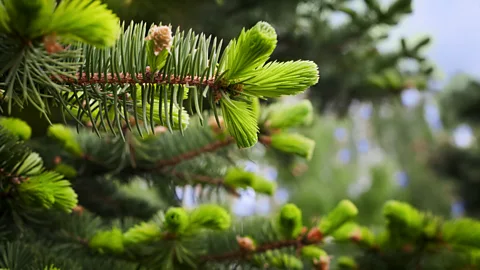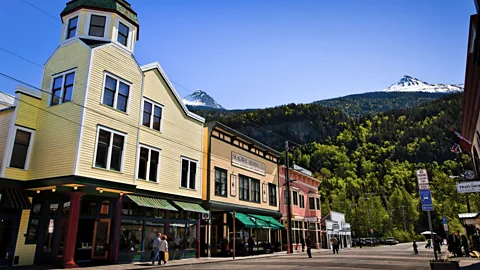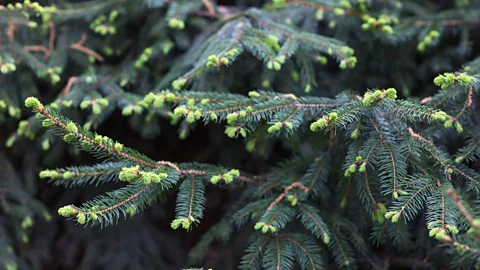The Alaska town where money grows on trees
 Julia_Sudnitskaya/Getty Images
Julia_Sudnitskaya/Getty ImagesIn Skagway, the gateway to the Klondike, spruce tips play an important role in the local economy, with locals and visitors trading them for cash and goods.
A year after moving to Skagway, Alaska, John Sasfai walked into Skagway Brewing Co. and ordered the signature Spruce Tip Blonde Ale. But instead of pulling out his wallet, the guide for Klondike Tours put a sack of spruce tips on the bar to pay his tab.
That’s because in this town, the bounty he foraged from trees near Klondike Gold Rush National Historical Park serves as a currency.
This village, with a year-round population just shy of 1,000, is notably remote – it’s about 100 miles north of Juneau and 800 miles south-east of Anchorage by car. And though stampeders established Skagway during the late-19th-Century gold rush, these days the nuggets of value are plucked from the forest, not panned or mined. While spruce tips – the buds that develop on the ends of spruce tree branches – are only good for cash at Skagway Brewing Co., bartering with spruce tips for food, firewood or coffee (which are delivered by barge once a week) is not uncommon.
 Julia_Sudnitskaya/Getty Images
Julia_Sudnitskaya/Getty ImagesAt 07:00 on a Friday morning in April, I boarded the LeConte for a seven-hour boat journey up the Inside age from Juneau to Skagway. Seasonal workers filled the ferry to report for their first shifts at local businesses as the cruise season loomed on the horizon.
You may also be interested in:
• Where you can drink a ‘Christmas tree’
A group of 20- and 30-somethings played poker in the ship’s cafeteria – first with packets of Sweet’N Low and creamers, then actual cash. But if anyone needed extra money, I mentioned to them, there was always the option of picking spruce tips to barter.
“Oh, I’ve heard the lore,” said Kevin Courtain, a lanky 26-year-old Oregon native returning to Alaska for his third season to work as a tour guide. “I guess it’s not that different from what’s gone on here in the past. You would trade your gold for whatever you needed.”
Alaskan spruce-tip dealings began with the Tlingit tribe, who brewed the Vitamin C-rich tips into tea long before the arrival of British explorers. But Captain James Cook, who visited Alaska in the late 1770s, famously concocted a distinctive spruce-tip beer to help prevent scurvy among his sailors. The spruce tips are only tender enough to harvest for a week or two every year in spring, and though they’re salutary as ingredients in potables, spices and sauces, their antimicrobial quality also makes them popular in hand creams, salves and bug-bite ointments.
 Design Pics Inc/Alamy
Design Pics Inc/AlamyUpon disembarking at Skagway that afternoon, I made my way to the Red Onion Saloon, a former Gold Rush brothel that once offered ‘negotiable affection’ to prospectors for $5 (a week’s wages). Nowadays, it’s a popular gastropub, and that afternoon it would play host to the Garden City Market, featuring local entrepreneurs hawking their wares. I immediately met Annemarie Hasskamp, proprietor of Glacial Naturals, a company that makes artisanal products like candles, soaps and oils from locally sourced flora. At her booth, she showed me her spruce-tip beard oil and cooking spices.
Because there’s no commercial agricultural economy in Alaska, harvesting spruce tips is as close as people can get to living off the land for profit, Hasskamp told me. During the summer high season, Skagway welcomes some 10,000 daily cruise engers who come, in part, to savour various spruce tip products such as the Spruce Tip Blonde Ale and spruce tip ice cream.
“Spruce tips are a currency for me,” Hasskamp said. “Just the fact that I can go out and find something free and sustainably harvest something that I care about and turn it into a value-added food product – just by me doing that, it amplifies the monetary value it has for me.”
Foraging takes time and effort, but Hasskamp is making a mint one pinch off the tree at a time. She attributes the popularity of spruce tip products to the organic movement, the push for local food and the attendant appeal of wild-harvested goods in Skagway. And stocking up on spruce tips can be a lucrative bargaining chip in times of need, especially winter.
“Some people say, ‘Hey, I’ve got an extra bag of spruce tips in the freezer, do you want them?’,” Hasskamp said. “And you can’t let anything go without reciprocating here.”
 Ross Kenneth Urken
Ross Kenneth UrkenNear Hasskamp, Emily Grace Willis, owner of Maiden Alaska Herbals, was selling spruce tip hand salve and spruce tip honey, which she’d originally created to remedy her kids’ sore throats. “For me, the interaction between trees and humans is a little bit spiritual,” she said. “But if you collect something from the wild that’s not owned, then it kind of is like money growing on trees.”
Willis sells her products at local stores like Jewell Gardens and You Say Tomato, but she’s not necessarily as willing as others to trade her coveted leftover spruce tips. “I would be like: ‘No way, it takes a while to harvest those!’,” she said.
Mindy Miller, a lifelong Skagway resident whose family owns Klothes Rush, a downtown souvenir shop, said that, over the last few years, the spruce tip trend has taken off. And on the Skagway Swap Facebook group, which serves as the town’s main marketplace where locals barter for and list all kinds of items for sale, she has seen people looking to trade for spruce tips.
“I said, ‘What in the what?’,” Miller recalled, noting she’s dreamt of harvesting tips in her backyard. “Sometimes I joke to my husband that we should go on our one-acre property and see if we have any spruce trees. I don’t have spare time, but we can cash in here.”
That night, during a performance by a local reggae band at the Red Onion Saloon, I caught up with Orion Hanson, an elected Skagway assemblyman. Just the other week, he traded lumber with a fisherman for 10 fresh sockeye salmon, and he said this type of exchange and the spruce tip economy speak to the close-knit fabric of local culture here.
“Skagway was founded by stampeders with an entrepreneurial drive who stayed in this narrow valley because of a kindred, bohemian spirit,” Hanson said. “That community bond thrives today.”
 Ross Kenneth Urken
Ross Kenneth UrkenWhen I walked into Skagway Brewing Co.’s new 18,050-sq-ft restaurant and brewing facility the next day, brewmaster Trevor Clifford was experimenting with a new spruce tip lager for a beer festival and competition set to take place the last weekend in May in the nearby town of Haines.
A former home brewer, the Minnesota native left a secure job as an equipment maintenance worker to move to Skagway in 2007 when he was recruited by Skagway Brewing Co. owner Mike Healy. That spring, Clifford, Healy and their team went out to the forest to forage Sitka spruce tips, black spruce tips and hybrid varieties to make their first Spruce Tip Blonde Ale, which Clifford describes as sweet and citrusy with undertones of blueberry and spearmint. The team needed help with the harvest, though. The tips had always been a local commodity, and the brewery started accepting them as a form of payment.
Until 2016, the going rate for a pound of spruce tips at the brewery was $4, or a pint of beer. After examining state liquor laws, Healy determined the brewery couldn’t legally offer beer as compensation, so in 2017, it switched over to a cash-for-spruce system and upped the per-pound rate to $5. Most people will still spend that money directly on beer anyway, Clifford said, and the newly expanded brewing facilities will help the brewery meet the uptick in demand for Spruce Tip Blonde Ale.
 Ross Kenneth Urken
Ross Kenneth UrkenGathering the tips has become a community-building tradition that is also a welcome boost for seasonal workers, Clifford said, who often arrive broke after having spent most of their money travelling to Skagway.
“They’re just starting to get a pay-cheque by the time the spruce tips are coming out, but that money has already been allocated to rent, groceries and paying off their credit card bill from getting up here. So people are excited to get some money off the trees,” Clifford said.
Clifford called the payment for foraged tips the ‘spruce tree dividend’, a jocular reference to the Alaska Permanent Fund, a $65bn reserve, funded mostly by oil revenue, that pays out an annual dividend of around $2,000 to each resident who has lived in Alaska for a full calendar year and intends to remain in the state long term. It’s an incentive to keep people in the state by sharing the bounty of its natural resources. On a more localised level, Skagwayans can collectively profit from what nature provides in spruce tips.
Each season, the brewery staff collects about 200lbs of tips, and the locals harvest an additional 200lbs of their own. Anyone can participate, but it’s important to note that spruce tips can only be foraged in Klondike Gold Rush National Historical Park for personal use. A swath of treeless land separates the National Park Service land from the Municipality of Skagway land, from which people can collect tips for commercial purposes, such as selling them to the brewery.
 imageBROKER/Alamy
imageBROKER/AlamyOf course, I wanted to experience the practice for myself. So, adjusting the brim of my newly purchased imitation Stetson hat, I drove about 25 minutes to the head of Klondike Gold Rush National Historical Park’s Chilkoot Trail and crossed over into the heavily wooded Municipality of Skagway land. I felt like something of a gold prospector among the trees with an intense desire to strike it rich.
They say the spruce tips appear fluorescent green like the Aurora Borealis, but after two hours, I couldn’t find any.
Finally, I accepted that it was perhaps too early in the season and returned to town to nurse my sorrows over a Spruce Tip Blonde Ale at the brewery. I paid in cash and took a long pull. It had hints of lemon and orange and, without being too piny, the faintest taste of Christmas.
I soon had a ferry to catch out of town, and on my way to the terminal happened to meet Si Dennis, a 71-year-old Tlingit elder and Skagway lifer who has worked for the National Park Service for more than 35 years. He told me he used to harvest spruce tips as a child with his grandparents.
“Skagway is a lot different from how it was when I grew up,” he said. “When I was growing up, the woods were where I got all my food.”
 Anna Chaplygina/Getty Images
Anna Chaplygina/Getty ImagesFor prospective spruce-tip foragers, Dennis said, patience is of the essence. It can sometimes require hours in the forest to collect a good bounty. Harvesters must also be strategic: they can’t pick tips that are not ripe enough or those that are too mature and bereft of the proper sugar concentration. They also have to be mindful of not picking too many tips from any one tree.
Dennis added that it’s important to recognise that the spruce tip system, integral to the culture up here, is also an important tradition to preserve and along.
“You have to respect nature and the power of spruce tips,” he said. “My grandmother and grandfather brought me up with the belief that if you spoil the land, you’re going to spoil it for the next generations.”
EDITOR’S NOTE: This article has been amended to clarify the circumstances under which John Sasfai used spruce tips to pay his tab at Skagway Brewing Co.
more than three million BBC Travel fans by liking us on Facebook, or follow us on Twitter and Instagram.
If you liked this story, sign up for the weekly bbc.com features newsletter called "The Essential List". A handpicked selection of stories from BBC Future, Culture, Capital and Travel, delivered to your inbox every Friday.
{"image":{"pid":""}}
